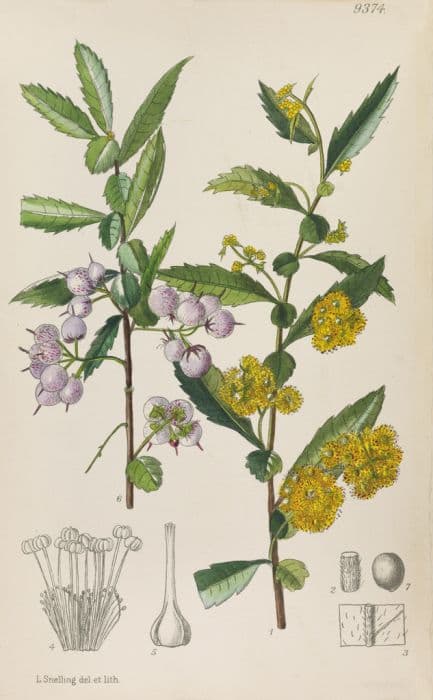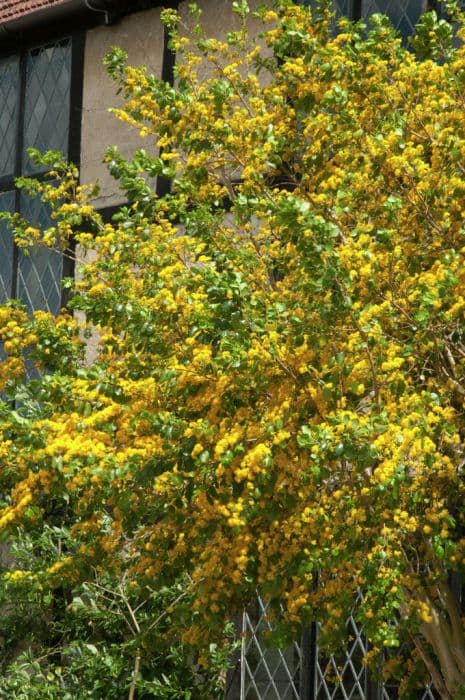Sawtoothed Azara Azara serrata

ABOUT
Azara serrata, commonly referred to as saw-toothed azara, is a visually appealing plant with a number of distinctive features. The plant showcases glossy, dark green leaves that have finely serrated edges, which is a characteristic that gives it its common name. The foliage often grows dense and can provide a lush appearance to the plant. During the flowering season, the saw-toothed azara produces small but abundant flowers that are generally creamy or yellowish in color. These flowers are typically notable for their pleasant fragrance, which can attract a variety of pollinators to the garden. After the blooming period, the plant may produce tiny, round berries that can add further interest to its appearance. These berries usually range in color from orange to red, though it can vary. Overall, the saw-toothed azara can be recognized by its serrated leaves, attractive blossoms, and occasionally present colorful berries.
About this plant
 Names
NamesFamily
Salicaceae.
Synonyms
Saw-Toothed Azara, Serrate Azara.
Common names
Azara petiolaris, Azara alpina, Azara lanceolata.
 Toxicity
ToxicityTo humans
Information on the toxicity of Azara serrata, commonly known as Saw-toothed Azara, to humans is limited. As with any plant, individual sensitivities can vary, and it is always advisable to exercise caution and avoid ingesting parts of plants that are not known to be edible. If Saw-toothed Azara is found to be toxic, symptoms of poisoning might typically include gastrointestinal distress, such as nausea, vomiting, or diarrhea. In some cases, more severe symptoms could occur, depending on the quantity consumed and individual reactions. It is crucial to seek medical attention if poisoning is suspected.
To pets
The toxicity of Azara serrata, or Saw-toothed Azara, to pets such as dogs and cats is not well-documented. Therefore, it is wise to prevent pets from ingesting any part of this plant. If the plant is found to be poisonous to pets, signs of toxicity may include vomiting, diarrhea, drooling, and lethargy. In severe cases, more serious symptoms could manifest. If you suspect that your pet has ingested any part of the Saw-toothed Azara and is showing adverse effects, it is important to contact a veterinarian promptly.
 Characteristics
CharacteristicsLife cycle
Perennials
Foliage type
Evergreen
Color of leaves
Green
Flower color
Yellow
Height
12 feet (3.66 meters
Spread
8 feet (2.44 meters
Plant type
Shrub
Hardiness zones
8
Native area
Chile
Benefits
 General Benefits
General Benefits- Ornamental value: Azara serrata, also known as Saw-toothed Azara, is appreciated for its aesthetic appeal due to its glossy leaves and visually interesting form.
- Wildlife habitat: The plant offers shelter and breeding sites for various bird species and insects within its dense foliage.
- Aromatic flowers: The tiny, yellow flowers produce a vanilla-like fragrance that can be enjoyable for gardeners and passersby in the flowering season.
- Screening plant: Its dense growth habit makes it suitable for use as a natural privacy screen or hedge.
- Low maintenance: Saw-toothed Azara requires minimal upkeep once established, making it a hassle-free addition to landscapes.
- Urban adaptability: This plant can thrive in urban conditions, tolerating pollution and offering greenery in city environments.
- Seasonal interest: It provides year-round interest with its evergreen leaves, fragrant spring flowers, and sometimes ornamental berries.
 Medical Properties
Medical PropertiesThis plant is not used for medical purposes.
 Air-purifying Qualities
Air-purifying QualitiesThis plant is not specifically known for air purifying qualities.
 Other Uses
Other Uses- Insect Attractant: Azara serrata can be used in gardens to attract beneficial insects, such as bees and butterflies, which help pollinate plants.
- Hedging: Due to its dense foliage, Azara serrata is often used to create privacy hedges or garden borders.
- Topiary: The plant's growth habit and evergreen leaves make it suitable for shaping into topiaries for decorative purposes.
- Windbreak: Planting Azara serrata in a row can act as a windbreak to protect more delicate plants and reduce soil erosion.
- Sound Barrier: The thick foliage of Azara serrata can help to absorb sound, making it an ideal plant for urban gardens to reduce noise pollution.
- Soil Stabilization: Its root system can help prevent soil erosion on slopes and embankments.
- Ornamental Fruit: The small yellow berries that follow the flowers can provide visual interest in a garden setting.
- Woodworking: The wood of Azara serrata can be used in woodworking for crafting small objects, as it is relatively hard and fine-grained.
- Dye Production: The leaves and bark of Azara serrata may be used in the production of natural dyes for textiles.
- Bonsai: Azara serrata can be trained as a bonsai, offering a year-round display of miniature foliage and flowers in small-scale gardening.
Interesting Facts
 Feng Shui
Feng ShuiAzara serrata is not used in Feng Shui practice.
 Zodiac Sign Compitability
Zodiac Sign CompitabilityAzara serrata is not used in astrology practice.
 Plant Symbolism
Plant Symbolism- Obscurity: Azara serrata is not a well-known plant, so it can symbolize the hidden or the overlooked, encouraging us to find beauty in the less obvious.
- Resilience: Being a hardy plant that can adapt to different environments, it represents the ability to endure and thrive in various conditions.
- Precision: The serrated edges of its leaves can represent meticulousness and precision, symbolizing a keen attention to detail.
- Growth: As with many plants, Azara serrata represents growth and the natural progression of life, reminding us of the potential to evolve and develop over time.
 Water
WaterAzara microphylla, commonly known as boxleaf azara, should be watered deeply and allowed to dry partially between waterings to encourage a strong root system. Young plants may require water once a week, while established plants may need watering every two to three weeks during dry spells. Typically, 1 to 2 gallons per plant per watering session should suffice, adjusting for climate and seasonal changes. During the hot summer months, more frequent watering may be necessary. In contrast, during the winter, water sparingly, just enough to prevent the soil from completely drying out.
 Light
LightBoxleaf azara thrives in a spot with full sun to partial shade. It prefers a location that receives several hours of direct sunlight each day, but it can also tolerate some shade, especially in hotter climates. Protect the plant from intense midday sun which can scorch the foliage, so a location with dappled sunlight or morning sun followed by afternoon shade would be ideal.
 Temperature
TemperatureBoxleaf azara is hardy and tolerates a range of temperatures but grows best when the climate is mild. It can survive minimum temperatures down to about 20 degrees Fahrenheit, but ideally, it should be kept in conditions that don't drop below 30 degrees Fahrenheit. The optimal temperature range for this shrub is between 60 and 75 degrees Fahrenheit, where it can grow and flourish.
 Pruning
PruningBoxleaf azara should be pruned to maintain its desired shape and to remove any dead or damaged branches. The best time to prune is in the late winter or early spring before new growth begins. Pruning can be done annually or as needed, and occasional thinning of older branches can encourage better air circulation and light penetration within the canopy.
 Cleaning
CleaningAs needed
 Soil
SoilThe best soil mix for the Azara serrata, commonly referred to as Saw-toothed Azara, should be well-draining, rich in organic matter, and slightly acidic to neutral in pH. An ideal soil mix can be made of two parts peat or coir, one part perlite, and one part compost with a pH between 5.5 and 7.0.
 Repotting
RepottingSaw-toothed Azara should be repotted every two to three years to refresh the soil and accommodate root growth. Spring is the best time for repotting this plant, ensuring that it has time to establish in the new soil before winter.
 Humidity & Misting
Humidity & MistingSaw-toothed Azara thrives in moderate to high humidity levels, ideally between 40-60%. It is important to maintain consistent humidity to facilitate healthy growth and prevent stress.
 Suitable locations
Suitable locationsIndoor
Place in bright, indirect light and maintain high humidity for indoor Saw-toothed Azara.
Outdoor
In partial shade, sheltered from wind, mulch well, protect from frost for outdoor Azara serrata.
Hardiness zone
8-10 USDA
 Life cycle
Life cycleAzara serrata, commonly known as the Saw-toothed Azara, begins its lifecycle as a seed, often requiring a period of stratification to break dormancy. Upon germination, a seedling emerges, developing a basic root system and cotyledons before true leaves appear, indicating the seedling stage. As it matures into a juvenile plant, it forms a woody stem and a more complex root system, and leaves become more characteristic of the species. Reaching the adult stage, Saw-toothed Azara develops flowers, usually small and inconspicuous, which are pollinated by insects to produce fruits containing seeds. The plant reaches reproductive maturity, and once pollinated, the flowers develop into small, berry-like fruits that disperse seeds for the next generation. Saw-toothed Azara is a perennial plant, and after its first flowering, it can continue to grow and reproduce for many years, completing its lifecycle.
 Propogation
PropogationPropogation time
Spring to Summer
Propogation: Azara serrata, commonly known as Azara, can be effectively propagated through semi-hardwood cuttings. The optimal time for taking cuttings is during the late summer to early fall. A semi-hardwood cutting is made from the current year's growth that has begun to mature and turn woody, yet is not fully hardened. It is best to select a healthy, disease-free branch, and make a cutting that is 4 to 6 inches (10 to 15 centimeters) long. The lower leaves are stripped, and the cut end is often dipped in rooting hormone to encourage root development. The cutting should be planted in a well-draining soil mix and kept moist but not waterlogged. A warm, humid environment such as that provided by a greenhouse or plastic cover can enhance rooting success.









